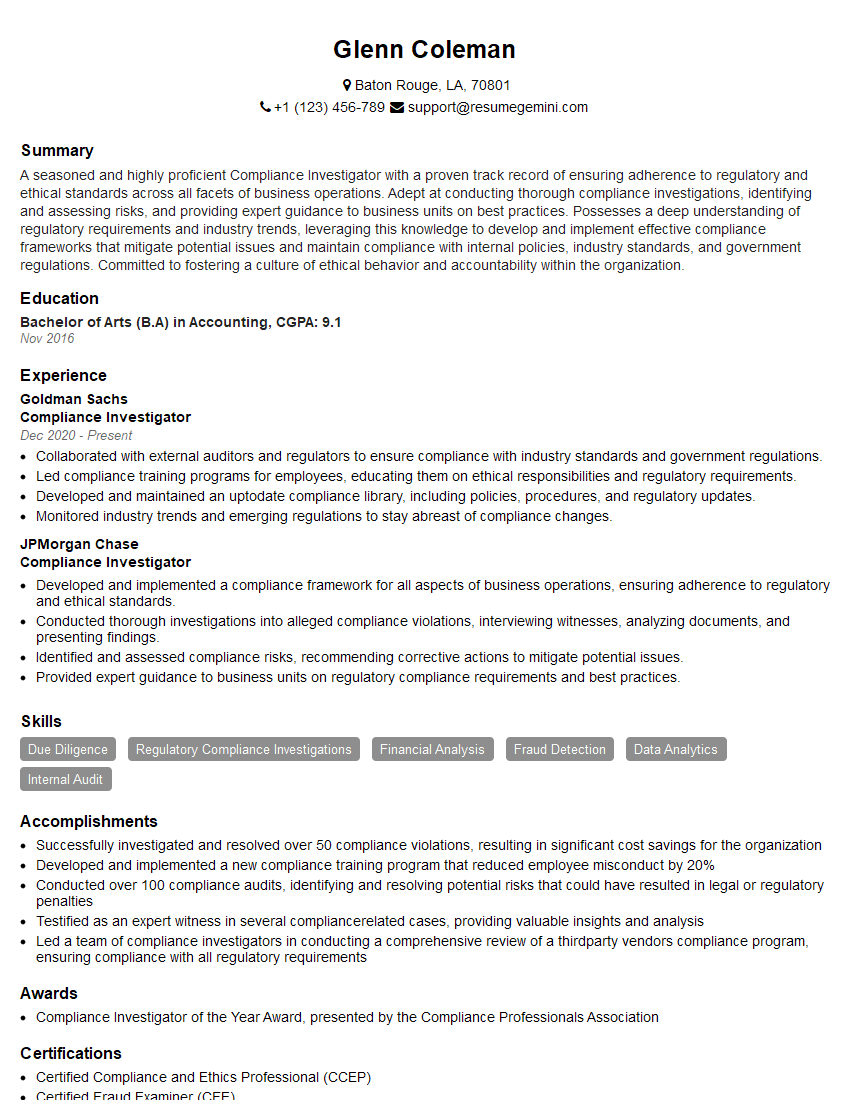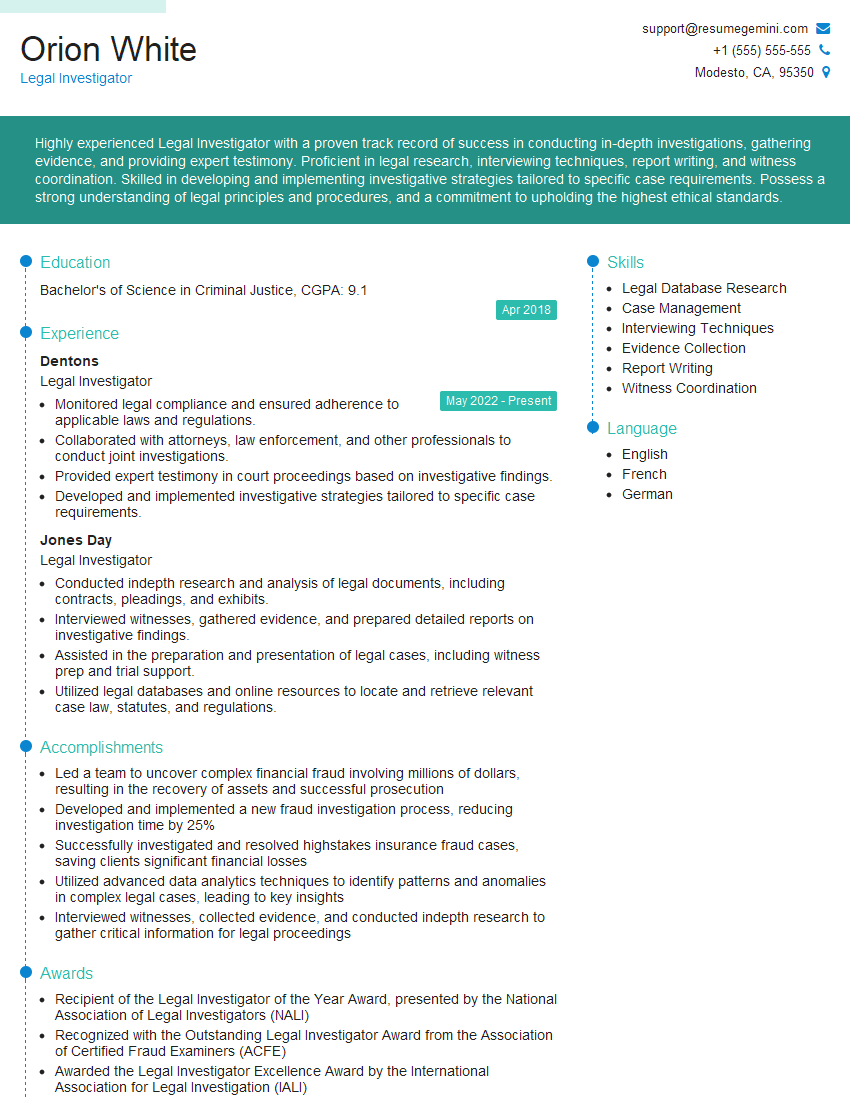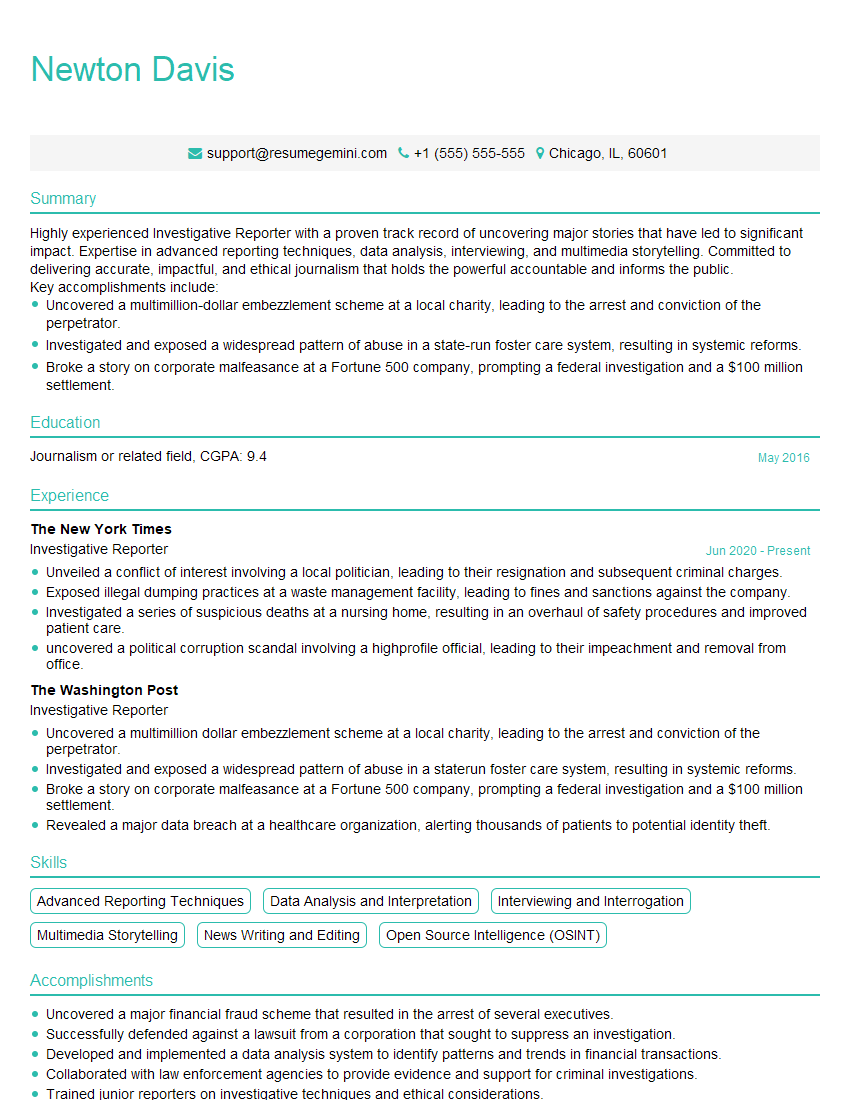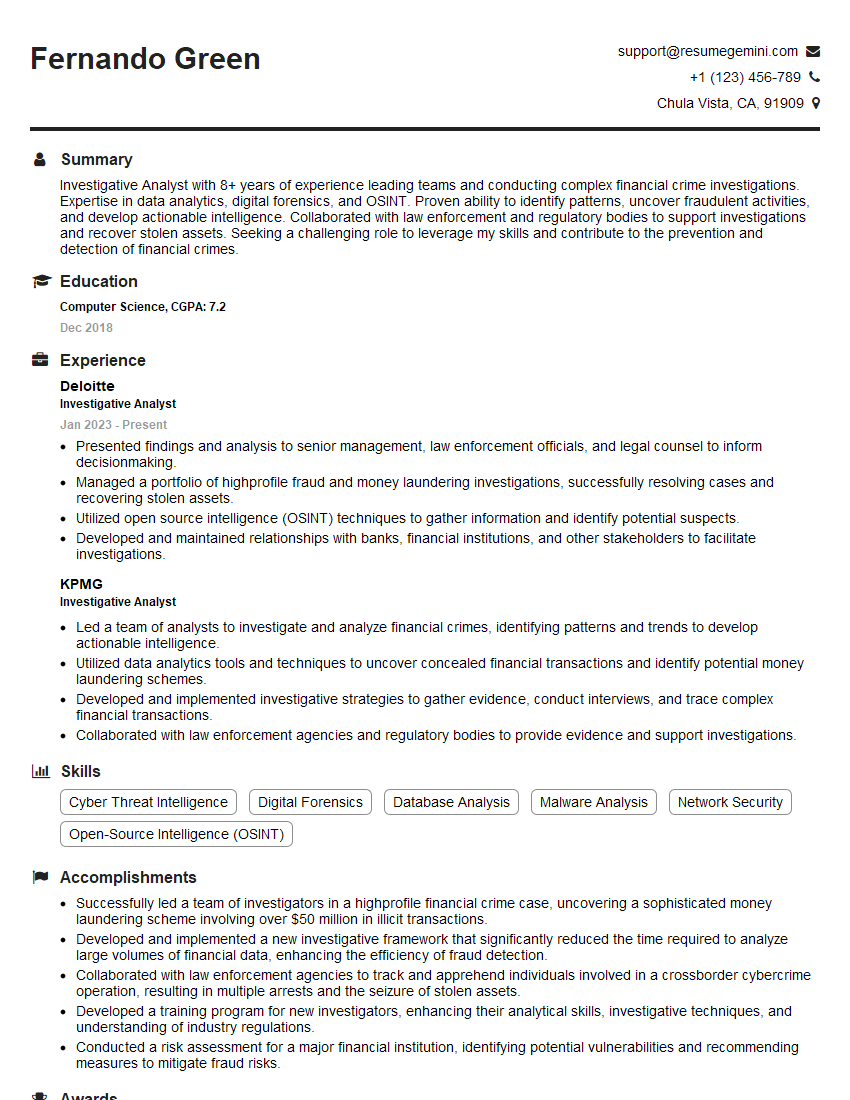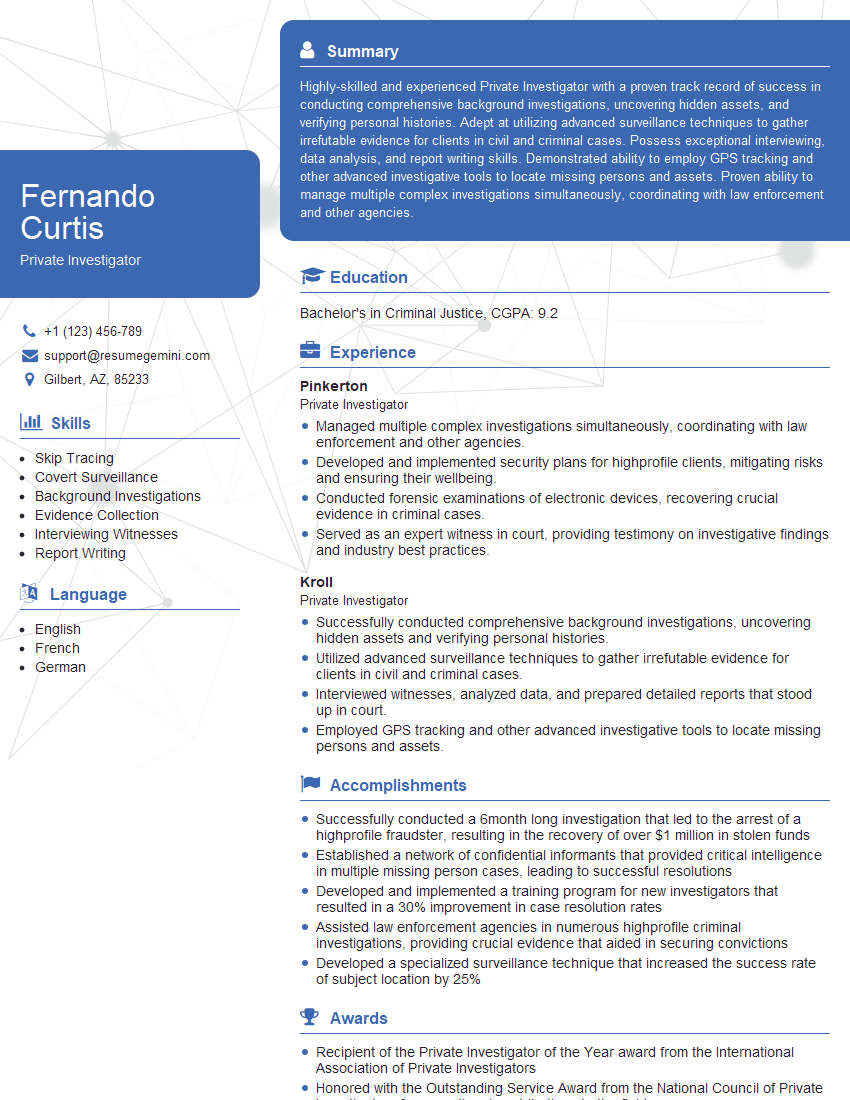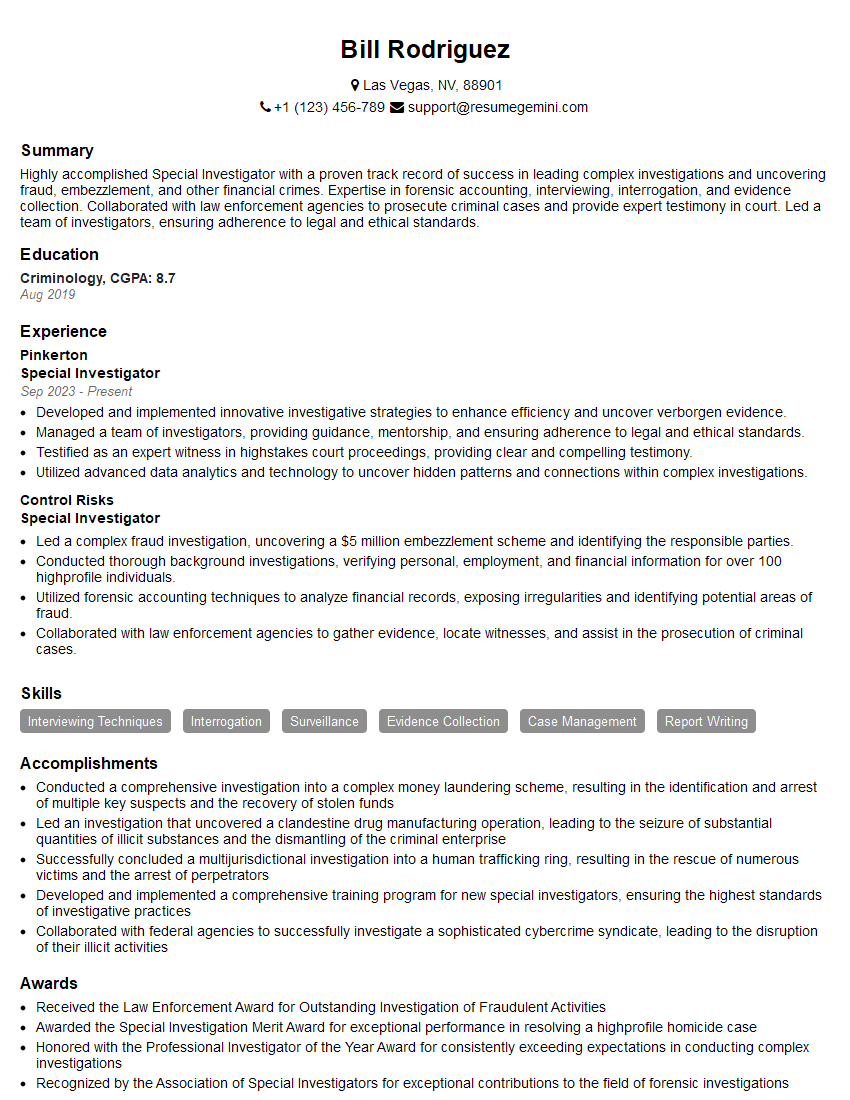Every successful interview starts with knowing what to expect. In this blog, we’ll take you through the top Investigative Reporting and Analysis interview questions, breaking them down with expert tips to help you deliver impactful answers. Step into your next interview fully prepared and ready to succeed.
Questions Asked in Investigative Reporting and Analysis Interview
Q 1. Describe your experience in verifying the authenticity of sources and information.
Verifying information authenticity is paramount in investigative reporting. It’s like being a detective – you can’t rely on a single clue; you need corroboration. My approach involves a multi-layered process. First, I assess the source’s credibility: Is this person an expert? Do they have a vested interest? Are their claims consistent with other information I’ve gathered?
Next, I cross-reference information with multiple independent sources. If three unrelated sources confirm a fact, my confidence level rises significantly. I also scrutinize the evidence itself – is it a primary source document? Is it dated? Are there any red flags like inconsistencies or alterations? I often use techniques like reverse image searches to check for manipulation or misrepresentation. For example, in investigating alleged corruption in a local government, I didn’t rely solely on anonymous tips but cross-referenced them with public records, financial statements, and interviews with individuals who held differing perspectives. Only when there was consistent alignment across diverse sources did I consider the information credible.
Finally, I use fact-checking websites and databases to verify facts, dates, and figures. It’s crucial to be meticulous and persistent, treating each piece of information as a potential puzzle piece requiring thorough examination before it’s accepted into the bigger picture of the investigation.
Q 2. Explain your process for identifying and mitigating potential biases in your investigations.
Identifying and mitigating bias is critical. Think of it as cleaning a lens before taking a photograph – a smudged lens will distort the image. My process begins with self-reflection. I acknowledge my own potential biases, understanding that everyone has them. I actively seek diverse perspectives and interview individuals representing a range of viewpoints. I strive for balanced reporting, presenting all sides of an issue fairly.
In data analysis, I use statistical methods to detect outliers and unusual patterns that might point to biases in the data itself. For instance, if I’m analyzing crime statistics, I’d check for potential biases related to reporting practices or socioeconomic factors in different neighborhoods. If I notice such discrepancies, I investigate further to understand the underlying reasons. I also regularly review my work with colleagues, seeking feedback on potential blind spots or biases I might have missed.
Transparency is key. I clearly state the sources of my information and any potential limitations or biases in my reporting, allowing the audience to critically assess the information themselves. This active awareness and diligent effort to account for biases is what ensures the integrity and objectivity of my investigative work.
Q 3. How do you approach data analysis when investigating complex issues?
Data analysis is the backbone of many investigations. It’s like piecing together a jigsaw puzzle, only the pieces might be scattered and incomplete. I begin by defining the research question. What am I trying to find out? Then, I identify the relevant datasets. This often involves locating and accessing various data sources, including public records, databases, and social media platforms.
Next, I clean and prepare the data, removing inconsistencies and errors. This can involve significant time and effort. After this, I use appropriate statistical techniques and visualization tools to analyze the data. This might include regression analysis to identify correlations, cluster analysis to group similar data points, or network analysis to understand relationships between entities. For example, when examining financial transactions related to a suspected money laundering scheme, I’d use network analysis to map the flow of funds and identify key players involved. The goal is to uncover hidden patterns and insights that would otherwise remain invisible.
Finally, I interpret the findings and document my analysis carefully. This stage involves relating the data analysis back to the initial research question, and highlighting significant results and any limitations of the analysis. The entire process needs to be meticulous and documented to ensure repeatability and transparency.
Q 4. What techniques do you use to identify patterns and trends in large datasets?
Identifying patterns and trends in large datasets requires the right tools and techniques. Think of it as searching for constellations in a vast night sky. I use various methods, including:
- Data visualization: Creating charts, graphs, and maps can reveal hidden patterns that are difficult to spot in raw data. For example, a geographic heatmap might show crime hotspots or areas with high levels of pollution.
- Statistical analysis: Techniques like regression analysis, correlation analysis, and time series analysis can help identify relationships between variables and predict future trends.
- Machine learning algorithms: Algorithms like clustering and anomaly detection can automatically identify groups of similar data points or outliers that might indicate unusual activity. For example, anomaly detection might identify unusual patterns in financial transactions, potentially indicating fraud.
- Natural Language Processing (NLP): This technique is useful for analyzing textual data, such as news articles or social media posts, to identify key themes, sentiments, and trends.
The choice of techniques depends on the specific dataset and research question. The key is to use a combination of methods to gain a comprehensive understanding of the data.
Q 5. Describe your experience with open-source intelligence (OSINT) gathering and analysis.
Open-source intelligence (OSINT) is a crucial tool. It’s like being a digital archaeologist, carefully excavating information from publicly available sources. My experience involves systematically searching and analyzing information from a variety of sources, including:
- Social media platforms: I analyze posts, comments, and images to gather information on individuals, organizations, and events. I’m careful to verify information from social media, since it can be easily manipulated.
- Government websites and databases: These sources provide valuable information on public records, regulations, and government activities.
- News articles and blogs: I analyze news reports to gather information and identify potential leads.
- Images and videos: I use reverse image searches and video analysis techniques to verify the authenticity of multimedia content.
I use specialized OSINT tools and techniques to efficiently search and analyze this information. For instance, I might use a web scraping tool to gather data from multiple websites, or a social network analysis tool to map relationships between individuals. The entire process demands a keen eye for detail and strong critical thinking skills to discern credible information from misinformation.
Q 6. How do you prioritize multiple investigative leads simultaneously?
Prioritizing investigative leads is like managing a portfolio of investments. You need a strategic approach to maximize your return on effort. I use a system that combines urgency, importance, and feasibility. I prioritize leads based on factors like:
- Urgency: Leads with time-sensitive information, such as an imminent threat or a quickly expiring opportunity, get top priority.
- Importance: Leads that have the potential to significantly advance the investigation, providing critical evidence or insights, get prioritized over less significant leads.
- Feasibility: Leads that are realistically achievable given available resources and time constraints are favored over those that might be too complex or time-consuming to pursue immediately.
I often use project management tools and techniques to track progress, assign resources, and manage deadlines. I maintain a detailed log of each lead, its status, and the actions taken. Regular review and adjustment of priorities ensure that I focus my efforts on the most impactful aspects of the investigation.
Q 7. Explain your experience in conducting interviews with witnesses and suspects.
Conducting interviews is an art and a science. It’s about building rapport, extracting information, and verifying accuracy. My approach involves thorough preparation before the interview. This includes researching the interviewee, preparing a list of specific questions, and planning the interview setting.
During the interview, I aim to create a comfortable and non-judgmental atmosphere to encourage open and honest communication. I use active listening techniques, such as paraphrasing and summarizing, to ensure understanding and build trust. I also use open-ended questions to elicit detailed responses and avoid leading questions that might bias the answers. I often record interviews (with consent) to ensure accuracy and allow for detailed review later.
After the interview, I carefully review the recordings and notes, verifying the information against other sources. I always cross-reference information obtained from multiple sources and compare it with available evidence to ensure accuracy and consistency. For example, if a witness provides an account of an event, I would try to corroborate it with other witness accounts, physical evidence, or documentation.
Q 8. How do you handle conflicting information from multiple sources?
Handling conflicting information is a cornerstone of investigative reporting. It’s rarely a case of finding one perfect, unwavering truth; instead, it’s about triangulation and critical evaluation. Think of it like a detective piecing together a crime scene – one witness might say the suspect was wearing a blue shirt, another a red one. My approach is multi-faceted:
- Source Verification: I rigorously assess the credibility of each source. This includes looking at their past statements, potential biases, and any potential conflicts of interest. Are they an expert in the field? Do they have a history of reliability? Have they been previously proven inaccurate?
- Cross-Referencing: I cross-reference information across multiple independent sources. If several credible sources corroborate a piece of information, it strengthens its validity. Discrepancies, on the other hand, demand deeper investigation.
- Fact-Checking and Documentation: I meticulously document all sources and their claims. This detailed record allows me to trace back the origin of information and assess its reliability. I also fact-check claims using publicly available data, official records, and other independent verification methods.
- Contextualization: I consider the context surrounding the information. A seemingly contradictory statement might make sense within a specific timeframe or set of circumstances. Understanding the ‘why’ behind potentially conflicting information is crucial.
- Transparency: In my reports, I clearly acknowledge inconsistencies and present differing perspectives. This ensures transparency and allows the reader to draw their own informed conclusions based on the presented evidence.
For example, in an investigation into environmental pollution, I might receive conflicting data on pollution levels from a company, an environmental agency, and a community group. By comparing their methodologies, funding sources, and historical accuracy, I can assess the reliability of each source and present a comprehensive picture, acknowledging the nuances and uncertainties.
Q 9. Describe your experience in writing concise and accurate investigative reports.
Conciseness and accuracy are paramount in investigative reporting. Readers need clear, impactful information without unnecessary jargon or fluff. My approach emphasizes clarity and precision in every stage:
- Structured Outlining: Before writing, I create a detailed outline organizing the key findings, supporting evidence, and narrative flow. This ensures a logical and coherent presentation.
- Precise Language: I use precise language, avoiding ambiguity and generalizations. Each statement must be backed by verifiable evidence.
- Data-Driven Narrative: The report is built around the data, with the narrative serving to contextualize and interpret the findings.
- Multiple Revisions: I revise multiple times, focusing on clarity, conciseness, and accuracy. Seeking feedback from colleagues ensures objectivity and avoids bias.
- Fact-Checking and Editing: Rigorous fact-checking and editing are essential. I cross-check all data, verify names, dates, and locations, and carefully edit for grammatical errors and inconsistencies.
In a recent investigation into a public health crisis, I had to condense complex epidemiological data into a concise, easily understandable report for a wide audience. Through careful structuring, precise language, and data visualization, I successfully communicated the critical findings without overwhelming the reader.
Q 10. Explain your understanding of data privacy and ethical considerations in investigative reporting.
Data privacy and ethical considerations are central to my investigative work. I adhere strictly to legal and ethical guidelines, always prioritizing the privacy and well-being of individuals.
- Informed Consent: Whenever possible, I obtain informed consent from individuals before including their personal information in my reports. This includes explaining the purpose of the investigation and how their information will be used.
- Anonymization and Pseudonymization: I employ techniques such as anonymization and pseudonymization to protect the identity of sources and individuals involved in the investigation when necessary. This balance ensures anonymity without compromising the integrity of the reporting.
- Data Security: I take appropriate measures to protect the confidentiality of the data I collect, using secure storage methods and access controls.
- Minimization of Harm: I carefully consider the potential impact of my reporting on individuals and communities and take steps to minimize any potential harm. I always weigh the public interest against the potential for harm to individuals.
- Legal Compliance: I am well-versed in data protection laws and regulations (such as GDPR, CCPA, etc.) and ensure that my investigative work is fully compliant.
For example, in an investigation into financial fraud, I would need to handle sensitive financial information. I would ensure proper anonymization and would never disclose personally identifiable information without explicit consent, ensuring adherence to strict legal and ethical standards.
Q 11. How do you maintain objectivity and neutrality during an investigation?
Maintaining objectivity and neutrality is crucial to building trust and credibility. My approach involves:
- Awareness of Biases: I am acutely aware of my own potential biases and actively work to mitigate their influence on my investigation. This includes seeking out diverse perspectives and critically examining my own assumptions.
- Multiple Perspectives: I actively seek out multiple perspectives, including those that challenge my initial assumptions. I interview individuals from different backgrounds and viewpoints to get a holistic understanding of the issue.
- Fact-Based Reporting: I base my reports solely on verifiable facts and evidence, avoiding speculation or emotional language.
- Balanced Presentation: I strive to present information in a balanced and impartial manner, acknowledging different viewpoints and perspectives. This may involve presenting counterarguments or alternative explanations.
- Verification and Validation: I rigorously verify all information before incorporating it into my reports. I use multiple sources and triangulation methods to ensure the accuracy and reliability of my findings.
Imagine investigating a controversial policy. I wouldn’t simply rely on information from one side of the debate. I would seek comments from supporters and critics alike, ensuring a balanced and nuanced portrayal of the issue.
Q 12. Describe your experience in using data visualization tools to present investigative findings.
Data visualization is essential for communicating complex investigative findings clearly and effectively. I’m proficient in using various tools to create compelling visuals.
- Tools: I utilize tools such as Tableau, Power BI, and even simpler options like spreadsheet software with charting capabilities. The choice of tool depends on the complexity of the data and the desired level of visual sophistication.
- Chart Selection: I carefully choose appropriate chart types (bar charts, line graphs, maps, etc.) to effectively represent the data. The goal is to make the data accessible and understandable to a broad audience.
- Clarity and Simplicity: My visualizations are designed for clarity and simplicity. I avoid excessive clutter or overly complex designs. The visual should support the narrative, not distract from it.
- Interactive Elements: When appropriate, I incorporate interactive elements (such as hover-over details or filters) to allow readers to explore the data more deeply.
- Contextualization: I ensure that the visualizations are properly contextualized with clear labels, titles, and accompanying text.
For example, in an investigation into housing segregation, I used geographic information system (GIS) software to create interactive maps showing the distribution of different racial groups and housing prices. This visualization effectively communicated the patterns of segregation and their correlation with socioeconomic factors.
Q 13. How do you ensure the accuracy and reliability of your data sources?
Ensuring data accuracy and reliability is a critical aspect of investigative reporting. My process involves multiple layers of verification:
- Source Evaluation: I carefully evaluate the credibility of each data source. This includes assessing the source’s expertise, reputation, potential biases, and methodology.
- Data Validation: I use various methods to validate the data, including comparing it to data from other sources, checking for consistency and anomalies, and verifying the data’s methodology.
- Triangulation: I often use triangulation, comparing data from multiple independent sources to confirm its accuracy. Agreement among multiple credible sources greatly strengthens the reliability of the data.
- Data Cleaning: I carefully clean the data to remove errors, inconsistencies, and outliers. This often involves using data cleaning techniques to address issues such as missing values or duplicates.
- Documentation: I maintain meticulous records of all data sources, including their origins, methodologies, and any limitations.
For example, if I’m using government statistics, I’d cross-reference them with data from independent research organizations or academic studies to confirm their accuracy. Discrepancies would prompt further investigation into the methodology and potential biases.
Q 14. Explain your experience in using specific investigative software or tools.
My experience encompasses a range of investigative software and tools, depending on the nature of the investigation. These tools enhance efficiency and accuracy:
- Data Analysis Software: I use statistical software like R or Python with relevant libraries (e.g., Pandas, NumPy) for data manipulation, analysis, and statistical modeling. This allows for complex data analysis and pattern identification.
- Document Review Software: For large-scale document reviews, I utilize tools that enable efficient keyword searching, text analysis, and document comparison. This helps analyze large datasets of documents for relevant information.
- Database Software: I use database management systems (e.g., SQL) for organizing and managing large datasets, enabling efficient querying and data retrieval. This ensures that I can readily access needed information and conduct in-depth analysis.
- Open-Source Intelligence (OSINT) Tools: I leverage OSINT tools and techniques to collect and analyze publicly available information from various online sources. This allows me to build a comprehensive picture of events or situations.
- Forensic Software (where applicable): In certain investigations, I may use specialized forensic software for analyzing digital evidence or metadata.
For instance, in investigating a complex financial scandal, I used Python to analyze massive financial transactions and detect anomalies, identifying patterns that would have been impossible to discern manually. The specific tools selected depend on the particular challenges of the investigation at hand.
Q 15. What is your experience with different research methodologies (e.g., qualitative, quantitative)?
Investigative reporting relies heavily on both qualitative and quantitative research methodologies. Qualitative research focuses on understanding the ‘why’ behind events, often involving in-depth interviews, document analysis, and observation. This approach helps uncover nuanced perspectives, motivations, and context. For instance, in investigating a corporate scandal, qualitative methods might involve interviewing whistleblowers to understand internal decision-making processes. Quantitative research, on the other hand, deals with numerical data, statistics, and measurable facts. This might include analyzing financial records, public datasets, or survey results to establish patterns, trends, and correlations. In the same corporate scandal example, quantitative research could involve analyzing financial statements to identify irregularities or comparing the company’s performance against industry benchmarks.
In practice, I often employ a mixed-methods approach, combining both qualitative and quantitative data to create a comprehensive and robust understanding. The qualitative data provides rich context and insight, while the quantitative data adds objectivity and strengthens the overall narrative. This integrated approach helps to paint a complete picture, minimizing bias and ensuring accuracy.
Career Expert Tips:
- Ace those interviews! Prepare effectively by reviewing the Top 50 Most Common Interview Questions on ResumeGemini.
- Navigate your job search with confidence! Explore a wide range of Career Tips on ResumeGemini. Learn about common challenges and recommendations to overcome them.
- Craft the perfect resume! Master the Art of Resume Writing with ResumeGemini’s guide. Showcase your unique qualifications and achievements effectively.
- Don’t miss out on holiday savings! Build your dream resume with ResumeGemini’s ATS optimized templates.
Q 16. How do you handle sensitive or confidential information during an investigation?
Handling sensitive or confidential information requires strict adherence to ethical and legal protocols. This begins with securing the information itself – using encrypted storage, password protection, and secure communication channels. Information is accessed on a need-to-know basis only. I meticulously document every source and its handling, maintaining a detailed audit trail. This is crucial for transparency and accountability. Furthermore, I always obtain informed consent whenever possible, ensuring sources understand how their information will be used and protected. In cases where anonymity is critical, I utilize strong anonymization techniques and work closely with legal counsel to ensure compliance with all applicable laws, including privacy regulations such as GDPR or HIPAA.
Imagine an investigation involving medical records. I would only access and use the minimum necessary data, following strict anonymization procedures. This might involve removing identifying information like names and addresses while retaining crucial data points that are relevant to the investigation. Every step of this process would be documented thoroughly.
Q 17. Describe your experience in working within legal and regulatory frameworks.
Operating within legal and regulatory frameworks is paramount in investigative reporting. My experience includes understanding and adhering to libel laws, defamation laws, privacy laws (like GDPR and CCPA), and laws related to accessing public records. Before publishing any piece, I conduct thorough legal reviews to ensure the accuracy and legality of my reporting. I am aware of the potential risks associated with publishing sensitive information and take precautions to mitigate them. This includes obtaining legal advice when necessary, and always ensuring that my reporting is truthful, fair, and does not violate any individual’s rights. Understanding the legal landscape allows me to navigate complex investigations effectively and ethically.
For example, in an investigation involving allegations of corporate misconduct, I would carefully review the relevant securities laws and regulations before publishing any findings that might impact the company’s stock price or reputation. I would also consult with legal counsel to ensure my reporting adheres to all applicable laws.
Q 18. How do you assess the credibility of anonymous sources?
Assessing the credibility of anonymous sources is a critical skill in investigative reporting. It’s a delicate balance between pursuing potentially crucial information and avoiding the spread of misinformation. I employ a multi-layered approach. Firstly, I assess the source’s knowledge and access to information. A source with firsthand knowledge and detailed information is more credible than one offering vague or secondhand accounts. Secondly, I look for corroboration. Do other sources or documents support the source’s claims? Thirdly, I assess the source’s motives. Are they seeking personal gain, revenge, or are they genuinely concerned about the truth? Finally, I use techniques to independently verify information, even if the source remains anonymous. This might involve cross-referencing facts with public records or interviewing other individuals.
For instance, if an anonymous source alleges illegal activity, I would verify the facts through independent sources like official documents or interviews with individuals unconnected to the source. This approach helps avoid relying solely on a single anonymous source.
Q 19. What strategies do you use to identify and address potential conflicts of interest?
Identifying and addressing potential conflicts of interest is vital for maintaining journalistic integrity. Transparency is key. I always disclose any potential conflicts, whether financial, personal, or professional. This might include any prior relationships with individuals or organizations involved in the investigation. I rigorously examine my own biases and assumptions to avoid influencing the investigation’s outcome. I maintain a strict separation between personal and professional life, ensuring that personal opinions or relationships don’t impact my journalistic work. If a conflict is unavoidable, I would recuse myself from the investigation and seek alternative reporters.
For example, if I were investigating a company where a close relative works, I would disclose this conflict immediately and likely recuse myself from the investigation to maintain neutrality.
Q 20. How do you handle situations where evidence is incomplete or contradictory?
Incomplete or contradictory evidence is a common challenge in investigative reporting. It requires careful analysis and a systematic approach. First, I meticulously document all available evidence, including inconsistencies. I then work to contextualize the evidence, considering the source, time frame, and potential biases. I may need to seek additional evidence, either through further interviews, document review, or public records searches. If contradictions persist, I acknowledge them openly and transparently in my reporting, explaining the limitations of the evidence and acknowledging the uncertainty. I avoid drawing conclusions based on incomplete information and focus on presenting a balanced picture that reflects the existing uncertainties.
For example, if there are conflicting accounts of an event, I would present both accounts clearly, highlighting the discrepancies and explaining why it’s difficult to reach a definitive conclusion based on the available evidence. The goal is to be accurate and transparent, not to force a narrative where one doesn’t exist.
Q 21. Describe your experience in presenting investigative findings to diverse audiences.
Presenting investigative findings effectively to diverse audiences requires adaptability and strong communication skills. I tailor my presentation to the specific audience’s background and understanding, avoiding jargon and technical terms when possible. For a lay audience, I might use clear, concise language and visual aids like charts or graphs to present complex information. For a more specialized audience, I might delve into the technical details and data analysis. Regardless of the audience, I focus on storytelling, weaving together the facts and evidence to create a compelling and engaging narrative. I’m also comfortable answering questions and engaging in discussions to ensure the findings are fully understood.
For example, I might present a complex financial investigation to a board of directors using detailed financial charts and data analysis, while presenting the same information to the general public using a simplified narrative that highlights the key findings and their implications.
Q 22. How do you manage time effectively when working under pressure and tight deadlines?
Effective time management under pressure is crucial in investigative reporting. It’s not just about working faster, but working smarter. My approach is a multi-pronged strategy. First, I prioritize tasks using methods like the Eisenhower Matrix (urgent/important), focusing on the high-impact activities that directly contribute to the investigation’s goals. Second, I break down large projects into smaller, manageable chunks with clearly defined deadlines for each. This makes the overall task less daunting and allows for better tracking of progress. Third, I utilize time-blocking techniques, scheduling specific times for focused work on particular aspects of the investigation, minimizing distractions. Finally, I regularly review my schedule and adjust as needed, acknowledging that unforeseen issues will arise and flexibility is key. For example, during a complex fraud investigation with a rapidly approaching deadline, I prioritized interviewing key witnesses first, then analyzed the gathered financial data, and finally compiled the report, adjusting my schedule daily based on new information or roadblocks encountered.
Q 23. Explain your proficiency in different data analysis techniques (e.g., regression analysis, correlation)?
Data analysis is fundamental to investigative reporting. I’m proficient in various techniques, including regression analysis and correlation, which I use to identify trends, patterns, and relationships within datasets. Regression analysis helps to model the relationship between a dependent variable and one or more independent variables. For example, I might use regression to model the relationship between advertising spending (independent) and sales revenue (dependent) to understand the effectiveness of marketing campaigns. Correlation analysis, on the other hand, measures the strength and direction of the linear relationship between two variables. I’d use correlation to see if there’s a link between the timing of suspicious transactions (variable A) and the period of unusually high employee turnover (variable B). I also utilize other techniques such as statistical significance testing (t-tests, chi-square tests) to ensure findings are reliable and not merely coincidental. Finally, data visualization tools like Tableau and Power BI are essential for communicating complex findings in a clear and compelling way to both expert and lay audiences.
Q 24. What is your understanding of different types of biases that can influence investigations?
Understanding bias is critical to conducting objective investigations. Several types of bias can creep into investigations, potentially leading to flawed conclusions. Confirmation bias, the tendency to favor information that confirms pre-existing beliefs, is a significant concern. For instance, an investigator who strongly suspects a particular individual might unconsciously interpret ambiguous evidence in a way that supports that suspicion. Selection bias can occur when the sample of data used isn’t representative of the larger population. For example, relying solely on publicly available information might miss crucial data held privately. Finally, anchoring bias can influence how information is weighted. The first piece of information received can disproportionately influence subsequent judgments. To mitigate these biases, I employ rigorous fact-checking, use multiple data sources, actively seek out contradictory evidence, and regularly reflect on my own assumptions and perspectives to maintain objectivity throughout the investigation.
Q 25. How do you utilize technology to improve the efficiency and effectiveness of investigations?
Technology significantly enhances investigative efficiency and effectiveness. Open-source intelligence (OSINT) tools allow me to gather information from publicly available sources like social media, government websites, and news archives. Data analytics software helps me process and analyze large datasets, identifying patterns and anomalies that might be missed by manual review. For instance, using SQL queries, I can quickly search through large databases of financial transactions to find specific patterns or outliers. Forensic software assists with the examination of digital evidence like computer hard drives and mobile devices. Secure communication platforms maintain confidentiality when collaborating with sources or team members. Finally, project management software is vital for organizing tasks, tracking progress, and ensuring effective collaboration within a team.
Q 26. Explain your experience in collaborating with other investigators or team members.
Collaboration is integral to successful investigations. In my previous role, I collaborated with a team of investigators on a complex money laundering case. We established clear roles and responsibilities from the outset, using project management tools to track individual tasks and ensure timely completion. Regular team meetings were crucial for sharing information, discussing challenges, and coordinating our efforts. Effective communication was paramount, and we utilized secure messaging platforms to share sensitive documents and information. Open communication and mutual respect facilitated constructive feedback and improved the overall effectiveness of our investigation. Openly sharing my expertise and actively listening to the insights of others fostered a collaborative and high-performing team environment.
Q 27. Describe your experience in working with legal teams to support litigation or regulatory processes.
I have extensive experience working with legal teams to support litigation and regulatory processes. This involves providing detailed reports, presenting evidence clearly and concisely, and testifying under oath when necessary. My understanding of legal procedures ensures that my findings are presented in a legally sound and defensible manner. For example, in a recent securities fraud case, I worked closely with the legal team to ensure that all evidence was meticulously documented and presented according to legal standards. This involved using appropriate legal terminology, following chain-of-custody protocols for evidence, and carefully considering the implications of my findings for the legal strategy. Maintaining open communication with the legal team is key to ensuring a successful outcome.
Q 28. How do you adapt your investigative approach based on the specific context or industry?
Adaptability is a cornerstone of effective investigative reporting. My investigative approach varies based on the specific context and industry. Investigations in the financial sector require a deep understanding of accounting practices and regulatory frameworks, while investigations in the healthcare industry necessitate familiarity with medical records and HIPAA regulations. For example, investigating a data breach in a technology company requires a different approach than investigating fraud within a non-profit organization. The sources of information, the relevant regulations, and the investigative techniques all differ. This necessitates a flexible mindset and the willingness to acquire new skills and knowledge as needed, always tailoring my approach to the specific nuances of the situation at hand.
Key Topics to Learn for Investigative Reporting and Analysis Interview
- Source Verification and Corroboration: Understanding techniques for verifying information from multiple sources, including open-source intelligence, and assessing credibility.
- Data Analysis and Interpretation: Applying statistical methods and visualization tools to uncover patterns and trends within datasets; interpreting findings accurately and drawing meaningful conclusions.
- Investigative Techniques: Mastering interviewing skills, public records research, and information gathering strategies to build a compelling narrative.
- Ethical Considerations in Investigative Journalism: Understanding and applying ethical principles related to privacy, confidentiality, and responsible reporting.
- Information Security and Privacy: Knowing best practices for protecting sensitive information and navigating legal and ethical challenges related to data security.
- Report Writing and Presentation: Constructing clear, concise, and compelling reports that effectively communicate complex information to diverse audiences.
- Problem-solving and Critical Thinking: Demonstrating the ability to analyze complex situations, identify key issues, and develop effective investigative strategies.
- Technology and Tools for Investigative Reporting: Familiarity with relevant software and databases used in investigative reporting and analysis (e.g., data visualization tools, social media analysis platforms).
Next Steps
Mastering Investigative Reporting and Analysis opens doors to exciting and impactful careers, allowing you to uncover truth, hold power accountable, and contribute to meaningful societal change. To maximize your job prospects, crafting a compelling and ATS-friendly resume is crucial. ResumeGemini can help you build a professional resume that showcases your skills and experience effectively. We provide examples of resumes tailored to Investigative Reporting and Analysis to guide you in creating a winning application. Take the next step towards your dream career – build your best resume with ResumeGemini today.
Explore more articles
Users Rating of Our Blogs
Share Your Experience
We value your feedback! Please rate our content and share your thoughts (optional).
What Readers Say About Our Blog
Hi, I’m Jay, we have a few potential clients that are interested in your services, thought you might be a good fit. I’d love to talk about the details, when do you have time to talk?
Best,
Jay
Founder | CEO
